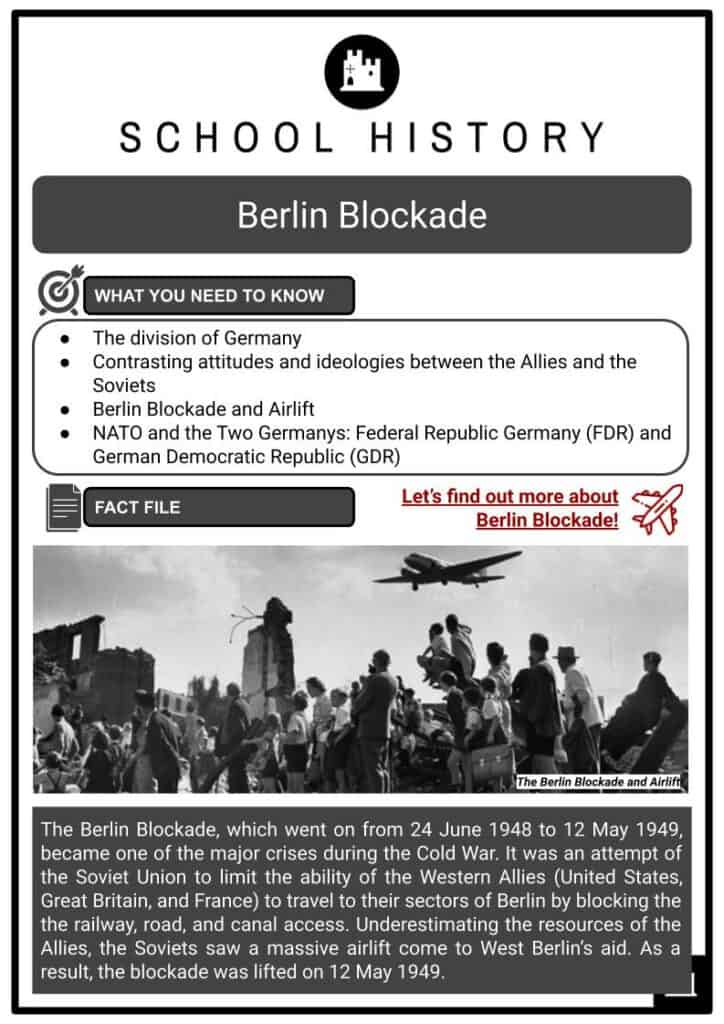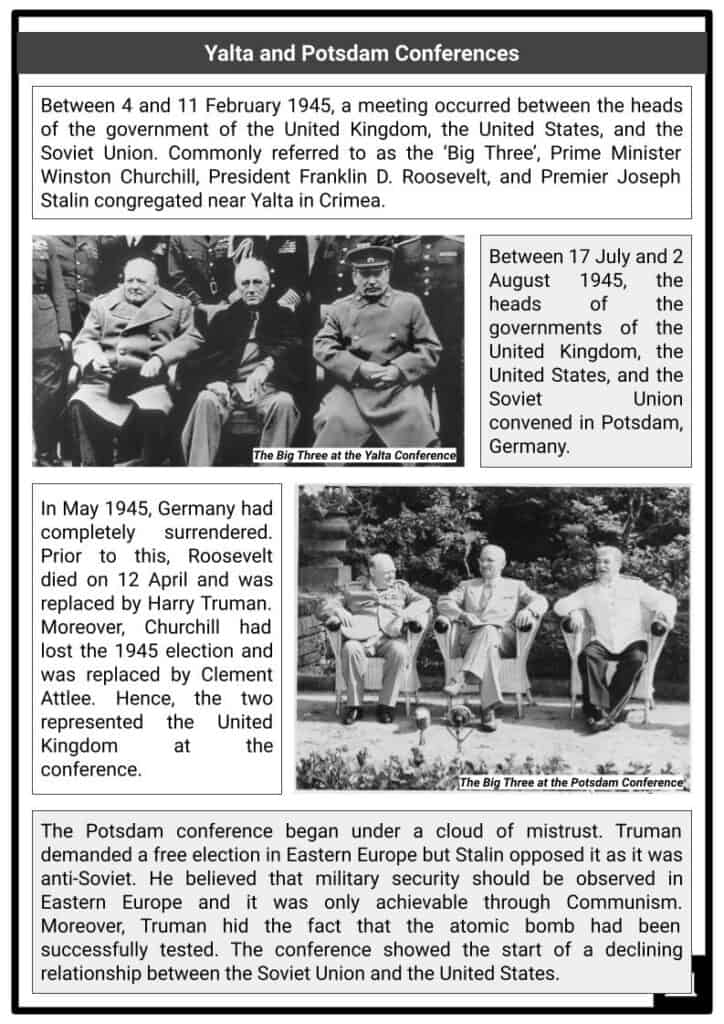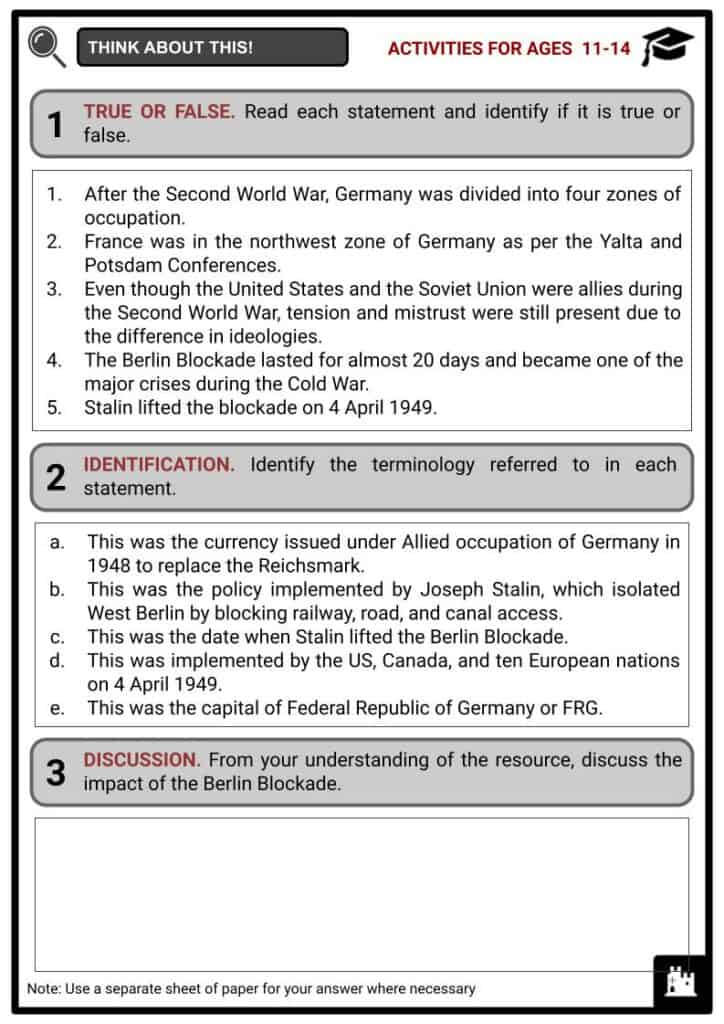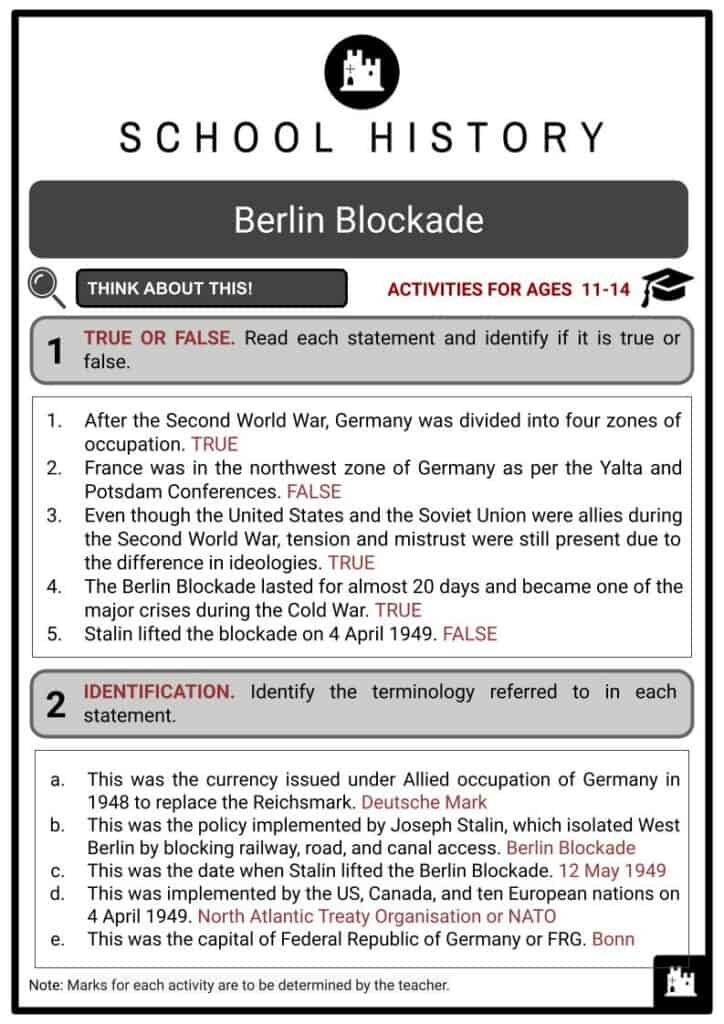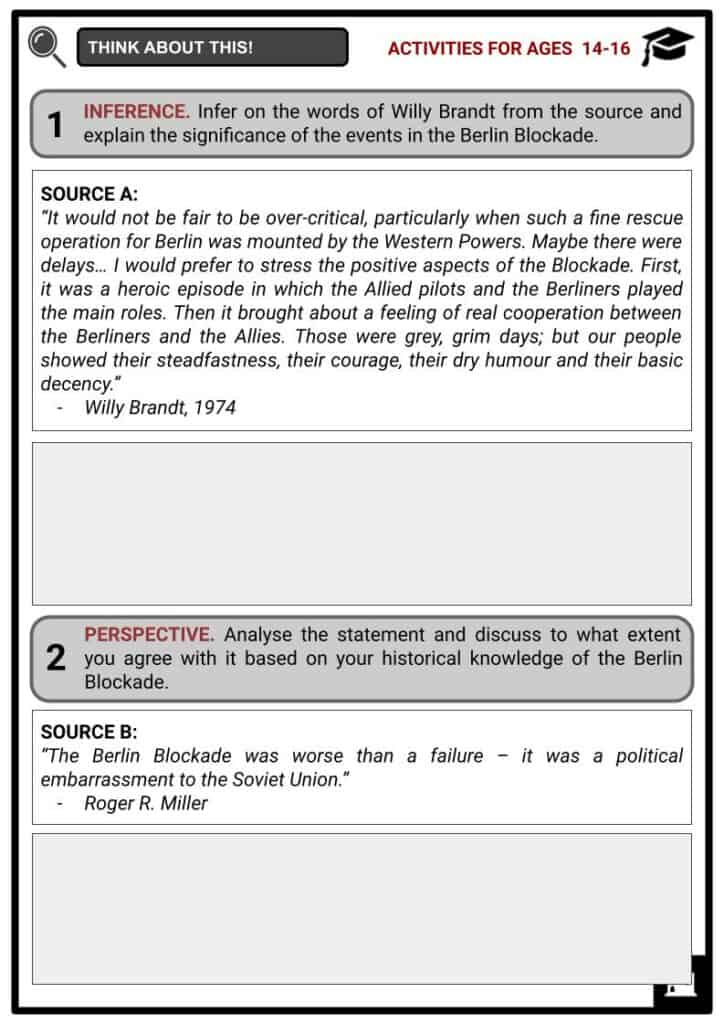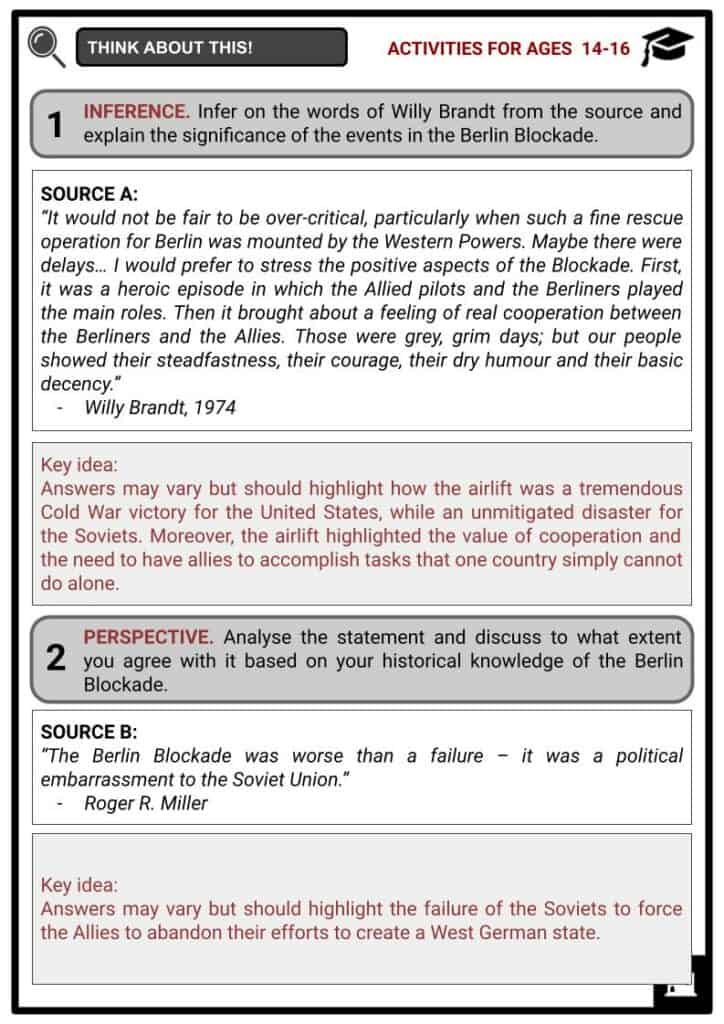Download Berlin Blockade Worksheets
Do you want to save dozens of hours in time? Get your evenings and weekends back? Be able to teach about the Berlin Blockade to your students?
Our worksheet bundle includes a fact file and printable worksheets and student activities. Perfect for both the classroom and homeschooling!
Summary
- The division of Germany
- Contrasting attitudes and ideologies between the Allies and the Soviets
- Berlin Blockade and Airlift
- NATO and the Two Germanys: Federal Republic Germany (FDR) and German Democratic Republic (GDR)
Key Facts And Information
Let’s know more about the Berlin Blockade!
The Berlin Blockade, which went on from 24 June 1948 to 12 May 1949, became one of the major crises during the Cold War. It was an attempt by the Soviet Union to limit the ability of the Western Allies (United States, Great Britain, and France) to travel to their sectors of Berlin by blocking the railway, road, and canal access. Underestimating the resources of the Allies, the Soviets saw a massive airlift come to West Berlin’s aid. As a result, the blockade was lifted on 12 May 1949.

Yalta and Potsdam Conferences
- Between 4 and 11 February 1945, a meeting occurred between the heads of the government of the United Kingdom, the United States, and the Soviet Union. Commonly referred to as the "Big Three," Prime Minister Winston Churchill, President Franklin D. Roosevelt, and Premier Joseph Stalin congregated near Yalta in Crimea.
- Between 17 July and 2 August 1945, the heads of the governments of the United Kingdom, the United States, and the Soviet Union convened in Potsdam, Germany.
- In May 1945, Germany had completely surrendered. Prior to this, Roosevelt died on 12 April and was replaced by Harry Truman. Moreover, Churchill had lost the 1945 election and was replaced by Clement Attlee. Hence, the two represented the United Kingdom at the conference.
- The Potsdam conference began under a cloud of mistrust. Truman demanded a free election in Eastern Europe but Stalin opposed it as it was anti-Soviet. He believed that military security should be observed in Eastern Europe and it was only achievable through Communism. Moreover, Truman hid the fact that the atomic bomb had been successfully tested. The conference showed the start of a declining relationship between the Soviet Union and the United States.
The Division of Germany
- After the Second World War, Germany was divided into four zones of occupation. As per the Yalta and Potsdam Conferences, the zones were placed under the control of the United States, the United Kingdom, France, and the Soviet Union.
- The four military occupation zones consisted of Great Britain in the northwest, the Soviet Union in the east, the United States in the south, and France in the southwest. They exercised sovereign power over these zones, which were treated as one country as per their 1937 territorial rights prior to Nazi expansion.
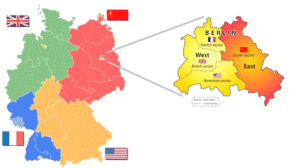
- Eastwards, the Soviet Union and Poland were given control as per the Oder-Neisse line. It bordered Germany from Poland as the line ran along the Oder and Lusatian Neisse rivers.
Contrasting Attitudes and Ideologies
- Franklin Roosevelt hoped to ensure the participation of the Big Three in the formulation of a post-war international organisation, the United Nations. Furthermore, he wanted to retain a close relationship with Stalin in order to defeat the Japanese in the Pacific. Upon his death on 12 April 1945, he was replaced by Harry Truman, his vice president. Unlike Roosevelt, Truman was not fond of Joseph Stalin. Furthermore, he was bold in his dislike of communism.
- Winston Churchill was alarmed with the motives of Stalin in Eastern Europe. On 28 July 1945, however, he was replaced by Clement Attlee. Unlike Churchill, Attlee remained sceptical and did not confront Stalin. On the other hand, Joseph Stalin wanted to exert the Soviet Union’s ‘sphere of influence’ over Eastern Europe. Moreover, he did not agree with the concept of ‘free elections’ in the freed countries.
- Even though the United States and the Soviet Union were allies during the Second World War, tension and mistrust were still present due to the difference in ideologies. The former promoted democracy and capitalism while the latter sought socialism as a political and economic system.
- The Soviets, in the span of 30 years, had suffered two German invasions from World War I and World War II. Hence, they wanted Germany to be a subordinate so it could never threaten Russia again. Moreover, they wanted it to act as a buffer zone between the Soviet Union and the Western powers.
- Stalin wanted to create a communist puppet state in Germany with the Allies out of Berlin. However, the Allies believed that Soviet expansionism could be prevented and a peaceful Europe could be achieved if there was a democratic Germany.
- The two powers with contrasting ideologies came to its reach over issues of currency because, at that time, Berlin was an economic ruin. By 1948, the Western powers began to secretly introduce a new currency behind Stalin’s back - the Deutsche Mark, and form a West German state. When the Soviets found out about it, they began to abandon the Four Power Council. In response to this, the Western Allies replaced the Reichsmark currency with the Deutsche Mark.
Berlin Blockade and Airlift
- By February 1948, the British, French, and American governments began to merge their zones economically to unify them and form a national government. In response, the Soviet Union imposed a blockade of Berlin to halt the process of unifying West Germany and to secure the Soviet-controlled territory in the eastern zone.
- The Berlin Blockade became one of the major crises during the Cold War. The Soviet Union blocked Allied access to West Berlin, which resulted in shortages of commodities including food, medicine, and fuel. At that time, West Berlin only had 36 days of food and 45 days of coal.
-
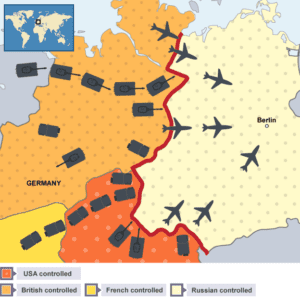
A map of the Berlin Airlift mission The Allies, at first, had 3 choices: (1) surrender their sectors to the communists, (2) let the city starve, or (3) act proactively risking another war. They went for none of the above and chose to supply all of Berlin using the method of airlift. So over the next 321 days, starting on 24 June 1948, the Allies airlifted supplies into Berlin using 275,000 flights to deliver 4,000 tons of supplies each day.
- Stalin underestimated the resources of the Allies and believed that an airlift was impossible. They set up three air corridors in Berlin but did not shoot any planes down in the time period, fearing that it would lead to another war.
- Despite Stalin’s blockade, many West Berliners attempted to leave the western side of Berlin. The city council and many students and teachers from Berlin University in the East established a new Free University in the West. As a result, Stalin lifted the blockade on 12 May 1949.
Impact of the Berlin Blockade
- The Berlin Blockade was the first serious conflict encountered by the leaders of the Grand Alliance.
- Many Germans living in the Eastern bloc attempted to move to West Berlin.
- This event was among the obvious turning points of the Cold War.
- The US backed NATO, while the USSR was under the Warsaw Pact.
- After the blockade, Western allies became more determined to build up West Berlin.
NATO and the Two Germanys
- On 4 April 1949, NATO, or the North Atlantic Treaty Organisation, was implemented by the US, Canada, and ten European nations. The organisation was established to secure the freedom of countries as founded in the idea of democracy.
- British Foreign secretary Ernest Bevin was the man behind the idea of creating NATO. Initially, the Western Union was formed in March 1948 and was comprised of Britain, France, Belgium, the Netherlands, and Luxembourg. In 1950, Dwight D. Eisenhower became the Supreme Commander of NATO as appointed by President Harry S. Truman. Some scholars believe that the creation of NATO featured among the tensions that heightened the Cold War as NATO members prematurely reacted to possible Soviet aggression.
-
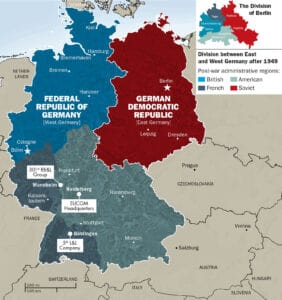
The Division of Germany Within weeks, West Germany finally became its own country, followed by Communist East Germany. West Germany called itself the Federal Republic of Germany (FRG) with Bonn as the capital. In order to govern the new country, 11 Länder were created to represent the Federal Parliament.
- Meanwhile, the USSR formed a separate country called the German Democratic Republic (GDR) in 1949 with East Berlin as the new capital. It was a one-party Communist state headed by Walter Ulbricht of the Socialist Unity Party (SED). The East German Parliament, called the Volkskammer, regularly held elections, which were won by members of the SED. The central committee was called the Politburo where all government decisions were made. Local government was divided into 14 districts called Bezirke.
Image Sources
- https://ichef.bbci.co.uk/images/ic/1008xn/p03hbgzd.jpg
- https://1.bp.blogspot.com/-hatz0rF5yTg/Xn5kD3J52oI/AAAAAAAAEBQ/uiOnlteai3caD5Sz6pnSIMZ7mnKHsj46wCLcBGAsYHQ/s1600/Germany%2Band%2BBerlin%2B-%2B4%2Bsectors.png
- https://bam.files.bbci.co.uk/bam/live/content/zq669qt/large
- https://arsof-history.org/articles/images/v11n1_psyche2/map_post_war_germany.jpg

